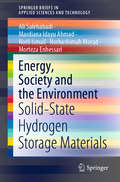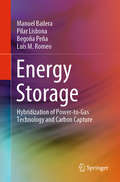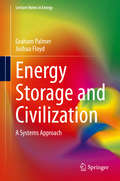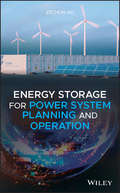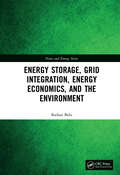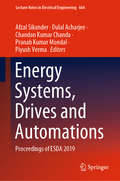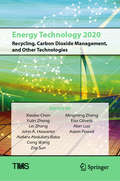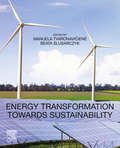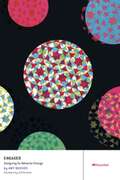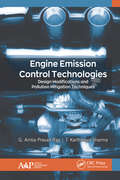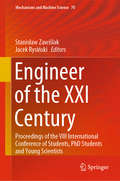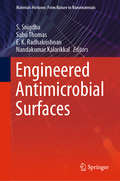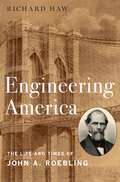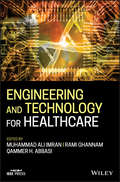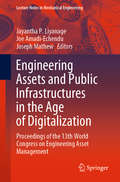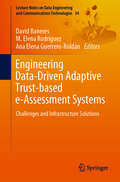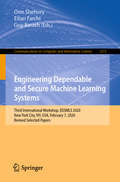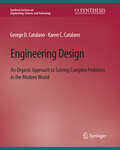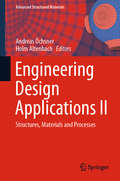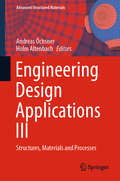- Table View
- List View
Energy, Society and the Environment: Solid-State Hydrogen Storage Materials (SpringerBriefs in Applied Sciences and Technology)
by Ali Salehabadi Mardiana Idayu Ahmad Norli Ismail Norhashimah Morad Morteza EnhessariThis book provides a comprehensive and contemporary overview of advances in energy and energy storage technologies. Although the coverage is varied and diverse, the book also addresses unifying patterns and trends in order to enrich readers’ understanding of energy and energy storage systems, particularly hydrogen energy storage, including e.g. their morphology, porosity and material structure. Readers will also gain insights into the hydrogen storage performance landscape, based on data released by the US Department of Energy (DOE), providing a basis for understanding real-world applications. The book also discusses the superior hydrogen storage performance of solid-state materials and explores the physical and chemical properties that can potentially affect their performance.
Energy Storage: Hybridization of Power-to-Gas Technology and Carbon Capture (Springerbriefs In Energy Ser.)
by Manuel Bailera Pilar Lisbona Begoña Peña Luis M. RomeoThis book presents a detailed analysis of Power-to-Gas, a promising energy storage technology. It discusses the main mechanisms involved, and presents two Power-to-Gas and carbon capture hybridizations. The book begins by providing an introduction to energy storage technologies. It then reviews a number of Power-to-Gas projects now in progress, highlighting the current barriers to commercializing the technology. Moreover, the book presents two novel Power-to-Gas hybridizations, which improve the technology’s applicability in terms of efficiency, utilization of resources and profitability. Given its scope, the book will be of interest to graduate students, researchers and practitioners in the fields of engineering and energy.
Energy Storage and Civilization: A Systems Approach (Lecture Notes in Energy #40)
by Graham Palmer Joshua FloydFossil fuels comprise the accumulation of prehistoric biomass that was energised by sunlight, and formed by earth system dynamics. Fossil fuels can be conceptualized as stored energy stocks that can be readily converted to power flows, on demand. A transition from a reliance on stored energy stocks, to renewable energy flows, will require a replication of energy storage by technological devices and energy conversion methods. Most analyses of energy storage focus solely on the economic-technical properties of storage within incumbent energy systems. This book broadens the scope of the study of storage by placing it within a broader, historical, biophysical framework. The role and value of storage is examined from first principles, and framed within the contemporary context of electrical grids and markets. The energy-economic cost of electrical storage may be critical to the efficacy of high penetration renewable scenarios, and understanding the costs and benefits of storage is needed for a proper assessment of storage in energy transition studies. This book provides a starting point for engineers, scientists and energy analysts for exploring the role of storage in energy transition studies, and for gaining an appreciation of the biophysical constraints of storage.
Energy Storage for Power System Planning and Operation
by Zechun HuAn authoritative guide to large-scale energy storage technologies and applications for power system planning and operation To reduce the dependence on fossil energy, renewable energy generation (represented by wind power and photovoltaic power generation) is a growing field worldwide. Energy Storage for Power System Planning and Operation offers an authoritative introduction to the rapidly evolving field of energy storage systems. Written by a noted expert on the topic, the book outlines a valuable framework for understanding the existing and most recent advances in technologies for integrating energy storage applications with power systems. Filled with full-color illustrations, the book reviews the state-of-the-art of energy storage systems and includes illustrative system models and simulations. The author explores the various techniques that can be employed for energy storage that is compatible with renewable energy generation. Designed as a practical resource, the book examines in detail the aspects of system optimization, planning, and dispatch. This important book, • Provides an introduction to the systematically different energy storage techniques with deployment potential in power systems • Models various energy storage systems for mathematical formulation and simulations • Contains a review of the techniques for integrating and operating energy storage with renewable energy generation • Analyses how to optimize power systems with energy storage, at both the transmission and distribution system levels • Shows how to optimize planning, siting, and sizing of energy storage for a range of purposes Written for power system engineers and researchers, Energy Storage for Power System Planning and Operation introduces the application of large-scale energy storage for the optimal operation and planning of power systems.
Energy Storage for Power System Planning and Operation
by Zechun HuAn authoritative guide to large-scale energy storage technologies and applications for power system planning and operation To reduce the dependence on fossil energy, renewable energy generation (represented by wind power and photovoltaic power generation) is a growing field worldwide. Energy Storage for Power System Planning and Operation offers an authoritative introduction to the rapidly evolving field of energy storage systems. Written by a noted expert on the topic, the book outlines a valuable framework for understanding the existing and most recent advances in technologies for integrating energy storage applications with power systems. Filled with full-color illustrations, the book reviews the state-of-the-art of energy storage systems and includes illustrative system models and simulations. The author explores the various techniques that can be employed for energy storage that is compatible with renewable energy generation. Designed as a practical resource, the book examines in detail the aspects of system optimization, planning, and dispatch. This important book, • Provides an introduction to the systematically different energy storage techniques with deployment potential in power systems • Models various energy storage systems for mathematical formulation and simulations • Contains a review of the techniques for integrating and operating energy storage with renewable energy generation • Analyses how to optimize power systems with energy storage, at both the transmission and distribution system levels • Shows how to optimize planning, siting, and sizing of energy storage for a range of purposes Written for power system engineers and researchers, Energy Storage for Power System Planning and Operation introduces the application of large-scale energy storage for the optimal operation and planning of power systems.
Energy Storage, Grid Integration, Energy Economics, and the Environment (Nano and Energy)
by Radian BeluThe book covers energy storage systems, bioenergy and hydrogen economy, grid integration of renewable energy systems, distributed generation, economic analysis, and environmental impacts of renewable energy systems. The overall approaches are interdisciplinary and comprehensive, covering economic, environmental, and grid integration issues as well as the physical and engineering aspects. Core issues discussed include mechanical, electrical, and thermal energy storage systems, batteries, fuel cells, biomass and biofuels, hydrogen economy, distributed generation, a brief presentation of microgrids, and in-depth discussions of economic analysis and methods of renewable energy systems, environmental impacts, life-cycle analysis, and energy conservation issues. With several solved examples, holistic material presentation, in-depth subject matter discussions and self-content material presentation, this textbook will appeal strongly to students and professional and nonprofessional readers who wish to understand this fascinating subject. Readers are encouraged to solve the problems and questions, which are useful ways to understand and apply the concepts and the topics included.
Energy Storage, Grid Integration, Energy Economics, and the Environment (Nano and Energy)
by Radian BeluThe book covers energy storage systems, bioenergy and hydrogen economy, grid integration of renewable energy systems, distributed generation, economic analysis, and environmental impacts of renewable energy systems. The overall approaches are interdisciplinary and comprehensive, covering economic, environmental, and grid integration issues as well as the physical and engineering aspects. Core issues discussed include mechanical, electrical, and thermal energy storage systems, batteries, fuel cells, biomass and biofuels, hydrogen economy, distributed generation, a brief presentation of microgrids, and in-depth discussions of economic analysis and methods of renewable energy systems, environmental impacts, life-cycle analysis, and energy conservation issues. With several solved examples, holistic material presentation, in-depth subject matter discussions and self-content material presentation, this textbook will appeal strongly to students and professional and nonprofessional readers who wish to understand this fascinating subject. Readers are encouraged to solve the problems and questions, which are useful ways to understand and apply the concepts and the topics included.
Energy Systems, Drives and Automations: Proceedings of ESDA 2019 (Lecture Notes in Electrical Engineering #664)
by Afzal Sikander Dulal Acharjee Chandan Kumar Chanda Pranab Kumar Mondal Piyush VermaThis book gathers selected research papers presented at the Second International Conference on Energy Systems, Drives and Automations (ESDA 2019), held in Kolkata on 28–29 December 2019. It covers a broad range of topics in the fields of renewable energy, power management, drive systems for electrical machines and automation. Also discussing a variety of related tools and techniques, the book offers a valuable resource for researchers, professionals and students in electrical and mechanical engineering disciplines.
Energy Technology 2020: Recycling, Carbon Dioxide Management, and Other Technologies (The Minerals, Metals & Materials Series)
by Xiaobo Chen Yulin Zhong Lei Zhang John A. Howarter Alafara Abdullahi Baba Cong Wang Ziqi Sun Mingming Zhang Elsa Olivetti Alan Luo Adam PowellThis collection addresses the pressing needs for sustainable technologies with reduced energy consumption and environmental pollutions and the development and application of alternative sustainable energy to maintain a green environment and efficient and long-lasting energy supply. Contributors represent both industry and academia and focus on new and efficient energy technologies including innovative ore beneficiation, smelting technologies, and recycling and waste heat recovery, as well as emerging novel energy solutions. The volume also covers a broad range of mature and new technological aspects of sustainable energy ecosystems, processes that improve energy efficiency, reduce thermal emissions, and reduce carbon dioxide and other greenhouse emissions. Authors also explore the valorization of materials and their embodied energy including byproducts or coproducts from ferrous and nonferrous industries, batteries, electronics, and other complex secondary materials.
Energy Transformation towards Sustainability
by Manuela Tvaronavičienė Beata ŚlusarczykEnergy Transformation towards Sustainability explores how researchers, businesses and policymakers can explore and usefully improve energy systems and energy consumption behavior, both to reflect the reality of climate change and related environmental degradation and to adapt to the expanding periphery of renewable energy technologies. It introduces the reader to a suite of potential policy pathways to the necessary transformation in societal energy consumption, usage and behavior. Solutions discussed include energy efficiency, energy security, the role of political leadership, green public policy, and the transition to renewable energy sources. International contributions address the range and depth of current research from a position of advocacy for ‘energy stewardship’ as the driver of this transformation. Case studies illustrate the range of various countries to diminish energy use. Finally, policy avenues are covered in depth.Reviews the interrelationship between economic growth, energy consumption and climate changeUses a wide variety of case studies to support practical implementation across national energy systemsHighlights a wide spectrum of urgent issues, including threats related to energy use and secure and sustainable developmentContains contributions that reflect a breadth and depth of scholarship from international backgrounds
Engaged: Designing For Behavior Change
by Amy BucherBehavior change design creates entrancing—and effective—products and experiences. Whether you've studied psychology or are new to the field, you can incorporate behavior change principles into your designs to help people achieve meaningful goals, learn and grow, and connect with one another. Engaged offers practical tips for design professionals to apply the psychology of engagement to their work.
Engaged: Designing For Behavior Change (PDF)
by Amy BucherBehavior change design creates entrancing—and effective—products and experiences. Whether you've studied psychology or are new to the field, you can incorporate behavior change principles into your designs to help people achieve meaningful goals, learn and grow, and connect with one another. Engaged offers practical tips for design professionals to apply the psychology of engagement to their work.
Engine Emission Control Technologies: Design Modifications and Pollution Mitigation Techniques
by G. Amba Prasad Rao T. Karthikeya SharmaThis new volume covers the important issues related to environmental emissions from SI and CI engines as well as their formation and various pollution mitigation techniques. The book addresses aspects of improvements in engine modification, such as design modifications for enhanced performance, both with conventional fuels as well as with new and alternative fuels. It also explores some new combustion concepts that will help to pave the way for complying with new emission concepts.Alternative fuels are addressed in this volume to help mitigate harmful emissions, and alternative power sources for automobiles are also discussed briefly to cover the switch over from fueled engines to electrics, including battery-powered electric vehicles and fuel cells. The authors explain the different technologies available to date to overcome the limitations of conventional prime movers (fueled by both fossil fuels and alternative fuels).Topics examined include:• Engine modifications needed to limit harmful emissions• The use of engine after-treatment devices to contain emissions• The development of new combustion concepts• Adoption of alternative fuels in existing engines• Switching over to electrics—advantages and limitations• Specifications of highly marketed automobiles• Emission measurement methods
Engine Emission Control Technologies: Design Modifications and Pollution Mitigation Techniques
by G. Amba Prasad Rao T. Karthikeya SharmaThis new volume covers the important issues related to environmental emissions from SI and CI engines as well as their formation and various pollution mitigation techniques. The book addresses aspects of improvements in engine modification, such as design modifications for enhanced performance, both with conventional fuels as well as with new and alternative fuels. It also explores some new combustion concepts that will help to pave the way for complying with new emission concepts.Alternative fuels are addressed in this volume to help mitigate harmful emissions, and alternative power sources for automobiles are also discussed briefly to cover the switch over from fueled engines to electrics, including battery-powered electric vehicles and fuel cells. The authors explain the different technologies available to date to overcome the limitations of conventional prime movers (fueled by both fossil fuels and alternative fuels).Topics examined include:• Engine modifications needed to limit harmful emissions• The use of engine after-treatment devices to contain emissions• The development of new combustion concepts• Adoption of alternative fuels in existing engines• Switching over to electrics—advantages and limitations• Specifications of highly marketed automobiles• Emission measurement methods
Engineer of the XXI Century: Proceedings of the VIII International Conference of Students, PhD Students and Young Scientists (Mechanisms and Machine Science #70)
by Stanisław Zawiślak Jacek RysińskiThis book gathers the proceedings of “Engineer of the XXI Century: The VIII Inter-University Conference of Students, PhD Students and Young Scientists”, which was held at the University of Bielsko-Biała (ATH), Poland, on the 8th of December 2017. The event highlighted outstanding research on mechatronics in the broadest sense, while also promoting cooperation among students and young scientists from around the globe. Topic areas covered include: mechanics and machine building, automation and robotics, mechatronics, production engineering and management, and informatics/computer science.
Engineered Antimicrobial Surfaces (Materials Horizons: From Nature to Nanomaterials)
by S. Snigdha Sabu Thomas E. K. Radhakrishnan Nandakumar KalarikkalThis volume looks at the different aspects involved in controlling microbial growth and the techniques employed in obtaining sterile surfaces. It covers research on coatings, nano-materials, herbal materials, naturally occurring antimicrobials in designing antimicrobial surfaces. It discusses issues of antibiotic resistance, synthesis techniques, toxicity, and current and potential applications of antimicrobial surfaces, and this book will serve as a useful reference to a broad range of scientists, industrial practitioners, graduate and undergraduate students, and other professionals in the fields of polymer science and engineering, materials science, surface science, bioengineering and chemical engineering.
Engineering America: The Life and Times of John A. Roebling
by Richard HawJohn Roebling was one of the nineteenth century's most brilliant engineers, ingenious inventors, successful manufacturers, and fascinating personalities. Raised in a German backwater amid the war-torn chaos of the Napoleonic Wars, he immigrated to the US in 1831, where he became wealthy and acclaimed, eventually receiving a carte-blanche contract to build one of the nineteenth century's most stupendous and daring works of engineering: a gigantic suspension bridge to span the East River between New York and Brooklyn. In between, he thought, wrote, and worked tirelessly. He dug canals and surveyed railroads; he planned communities and founded new industries. Horace Greeley called him "a model immigrant"; generations later, F. Scott Fitzgerald worked on a script for the movie version of his life. Like his finest creations, Roebling was held together by the delicate balance of countervailing forces. On the surface, his life was exemplary and his accomplishments legion. As an immigrant and employer, he was respected throughout the world. As an engineer, his works profoundly altered the physical landscape of America. He was a voracious reader, a fervent abolitionist, and an engaged social commentator. His understanding of the natural world, however, bordered on the occult and his opinions about medicine are best described as medieval. For a man of science and great self-certainty, he was also remarkably quick to seize on a whole host of fads and foolish trends. Yet Roebling held these strands together. Throughout his life, he believed in the moral application of science and technology, that bridges--along with other great works of connection, the Atlantic Cable, the Transcontinental Railroad--could help bring people together, erase divisions, and heal wounds. Like Walt Whitman, Roebling was deeply committed to the creation of a more perfect union, forged from the raw materials of the continent. John Roebling was a complex, deeply divided yet undoubtedly influential figure, and this biography illuminates not only his works but also the world of nineteenth-century America. Roebling's engineering feats are well known, but the man himself is not; for alongside the drama of large scale construction lies an equally rich drama of intellectual and social development and crisis, one that mirrored and reflected the great forces, trials, and failures of nineteenth century America.
Engineering and Technology for Healthcare (Wiley - IEEE)
by Muhammad Ali Imran Qammer H. Abbasi Rami GhannamInnovation in healthcare is currently a “hot” topic. Innovation allows us to think differently, to take risks and to develop ideas that are far better than existing solutions. Currently, there is no single book that covers all topics related to microelectronics, sensors, data, system integration and healthcare technology assessment in one reference. This book aims to critically evaluate current state-of-the-art technologies and provide readers with insights into developing new solutions. With contributions from a fully international team of experts across electrical engineering and biomedical fields, the book discusses how advances in sensing technology, computer science, communications systems and proteomics/genomics are influencing healthcare technology today.
Engineering and Technology for Healthcare (Wiley - IEEE)
by Muhammad Ali Imran Qammer H. Abbasi Rami GhannamInnovation in healthcare is currently a “hot” topic. Innovation allows us to think differently, to take risks and to develop ideas that are far better than existing solutions. Currently, there is no single book that covers all topics related to microelectronics, sensors, data, system integration and healthcare technology assessment in one reference. This book aims to critically evaluate current state-of-the-art technologies and provide readers with insights into developing new solutions. With contributions from a fully international team of experts across electrical engineering and biomedical fields, the book discusses how advances in sensing technology, computer science, communications systems and proteomics/genomics are influencing healthcare technology today.
Engineering Assets and Public Infrastructures in the Age of Digitalization: Proceedings of the 13th World Congress on Engineering Asset Management (Lecture Notes in Mechanical Engineering)
by Jayantha P. Liyanage Joe Amadi-Echendu Joseph MathewThis proceedings of the 13th World Congress on Engineering Asset Management covers a range of topics that are timely, relevant and practically important in the modern digital era towards safer, cost effective, efficient, and secure engineered assets such as production and manufacturing plants, process facilities, civil structures, equipment, machinery, and infrastructure. It has compiled some pioneering work by domain experts of the global Engineering Asset Management community representing both public and private sectors. The professional coverage of the book includes: Asset management in Industry 4.0;Standards and models;Sustainable assets and processes;Life cycle perspectives;Smart and safer assets;Applied data science;Workplace safety;Asset health;Advances in equipment condition monitoring;Critical asset processes; andInnovation strategy and entrepreneurshipThe breadth and depth of these state-of-the-art, comprehensive proceedings make them an excellent resource for asset management practitioners, researchers and academics, as well as undergraduate and postgraduate students.
Engineering Data-Driven Adaptive Trust-based e-Assessment Systems: Challenges and Infrastructure Solutions (Lecture Notes on Data Engineering and Communications Technologies #34)
by David Baneres M. Elena Rodríguez Ana Elena Guerrero-RoldánThis book shares original innovations, research, and lessons learned regarding teaching and technological perspectives on trust-based learning systems. Both perspectives are crucial to enhancing the e-Assessment process. In the course of the book, diverse areas of the computer sciences (machine learning, biometric recognition, cloud computing, and learning analytics, amongst others) are addressed. In addition, current trends, privacy, ethical issues, technological solutions, and adaptive educational models are described to provide readers with a global view on the state of the art, the latest challenges, and potential solutions in e-Assessment. As such, the book offers a valuable reference guide for industry, educational institutions, researchers, developers, and practitioners seeking to promote e-Assessment processes.
Engineering Dependable and Secure Machine Learning Systems: Third International Workshop, EDSMLS 2020, New York City, NY, USA, February 7, 2020, Revised Selected Papers (Communications in Computer and Information Science #1272)
by Onn Shehory Eitan Farchi Guy BarashThis book constitutes the revised selected papers of the Third International Workshop on Engineering Dependable and Secure Machine Learning Systems, EDSMLS 2020, held in New York City, NY, USA, in February 2020. The 7 full papers and 3 short papers were thoroughly reviewed and selected from 16 submissions. The volume presents original research on dependability and quality assurance of ML software systems, adversarial attacks on ML software systems, adversarial ML and software engineering, etc.
Engineering Design: An Organic Approach to Solving Complex Problems in the Modern World (Synthesis Lectures on Engineering, Science, and Technology)
by George D. Catalano Karen C. CatalanoWhile more and more undergraduate engineering programs are moving toward a multi-disciplinary capstone experience, there remains a need for a suitable textbook. The present text seeks to meet that need by providing a student friendly step by step template for this important and culminating academic journey beginning with the student design team's first meeting with the client to the final report and presentation. The text provides a wide range of design tools, a discussion of various design methodologies, a brief history of modern engineering, and a substantive consideration of engineering ethics. In addition, chapters are included on communication, team building and dealing with the inevitable obstacles that students encounter. Throughout the text, emphasis is placed upon the issues of environmental impact and the importance of diversity.
Engineering Design Applications II: Structures, Materials and Processes (Advanced Structured Materials #113)
by Andreas Öchsner Holm AltenbachThis book offers an update on recent developments in modern engineering design. Different engineering disciplines, such as mechanical, materials, computer and process engineering, provide the foundation for the design and development of improved structures, materials and processes. The modern design cycle is characterized by the interaction between various disciplines and a strong shift to computer-based approaches where only a few experiments are conducted for verification purposes. A major driver for this development is the increased demand for cost reduction, which is also linked to environmental demands. In the transportation industry (e.g. automotive or aerospace), the demand for higher fuel efficiency is related to reduced operational costs and less environmental damage. One way to fulfil such requirements is lighter structures and/or improved processes for energy conversion. Another emerging area is the interaction of classical engineering with the health and medical sector.
Engineering Design Applications III: Structures, Materials and Processes (Advanced Structured Materials #124)
by Andreas Öchsner Holm AltenbachThis book provides an update on recent advances in various areas of modern engineering design, such as mechanical, materials, computer, and process engineering, which provide the foundation for the development of improved structures, materials, and processes. The modern design cycle is characterized by the interaction of different disciplines and a strong shift toward computer-based approaches involving only a small number of experiments for verification purposes. A major driver for this development is the increased demand for cost reduction, which is also connected to environmental demands. In the transportation industry (e.g. automotive or aerospace), where there is a demand for greater fuel efficiency, one solution is lighter structures and/or improved processes for energy conversion. Another emerging area is the interaction of classical engineering with the health and medical sector.
